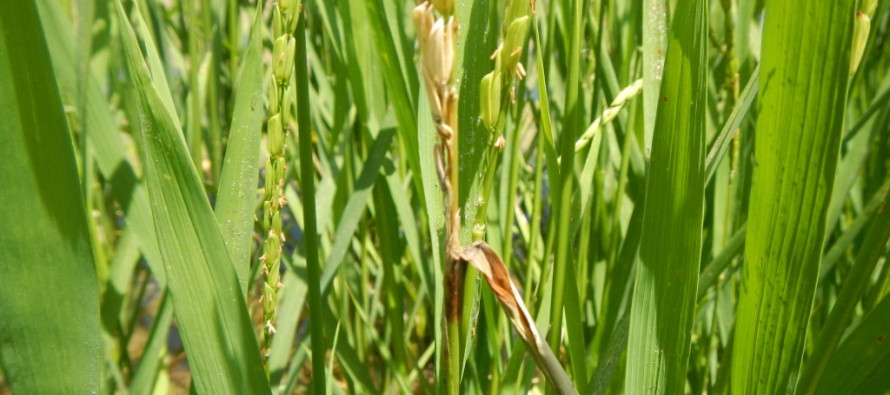Scouting and Managing Rice Blast

Scouting and Managing Rice Leaf Blast
Throughout the 2015 growing season numerous fields of blast-susceptible rice varieties have been observed to contain leaf blast throughout the Delta. To date, disease incidence has been relatively mild compared to 2014. In general, most fields where leaf blast occurrence was observed, producers have managed the complex well using field techniques such as maintaining adequate flood depth and reducing the midseason N rate, without the need for a fungicide application. However in certain areas the blast has progressed past the leaf phase and infected the necks. But, just because leaf blast has been observed in a field does not mean that neck blast will occur in the same field. As a point of reference, several fields south of Highway 82 progressed from having leaf blast on younger tillers almost 4 weeks ago to no observable leaf blast as of last Thursday (July 9, 2015) in the upper canopy. As of July 16, 2015, the particular fields were observed to contain observable neck blast in several fields of an extremely susceptible rice variety.
Blast symptoms
Leaf blast initially appears as maroon to brownish, diamond-shaped lesions that generally range in size from 1/8 to 1/4 of an inch. As lesions mature, and oftentimes when observed in the morning, they contain a brown to grayish center where fungal growth may occur if the environmental conditions persist and sporulation occurs. When blast progresses to the neck blast phase, portions of the neck will appear brown. As lesions on the neck mature the panicle itself can become discolored and bleached, particularly when sterile as a result of neck blast. When sterility results as a consequence of the disease the neck blast will result in a reduction of the transport of nutrients resulting in a lack of grain formation, hence the blank, white kernels that result.
Scouting
Scout areas of fields where the flood may not be as deep first (< 4 inches) before scouting areas of the field where the flood may be the deepest (4+ inches). Scout fields where a high seeding rate may have occurred or fields where the soil class tends to be closer to a silt loam rather than a clay. Pay particular attention to fields with tree lines and shaded areas on the eastern edge of the field that will act to increase prolonged periods of leaf wetness from early morning dews.
Managing blast
Maintaining a flood and not allowing the water levels to drop to a depth below 4 inches will ultimately reduce the likelihood of infection as well as decrease disease severity. In addition, mid-season nitrogen management may need to be altered in fields where leaf blast has been observed prior to panicle initiation (PI).
Fungicides, while effective management tools, should be used to manage neck blast, rather than applied to reduce symptoms of leaf blast. Keep in mind that fungicides will not completely eliminate the disease. Sporulation will continue to occur as the season progresses, especially at the time of heading. Fungicides will act to limit yield loss as a result of the disease. But, with that in mind, product selection changes drastically once the head emerges. Triazole (or DMI) fungicides typically have a pre-harvest interval that negates their use if closer than 45 days until harvest. However, stand-alone strobilurin fungicides that contain azoxystrobin can still be applied to reduce potential yield loss associated with neck blast.
Fungicide application timings
First applications for blast should be made when 50% of the rice plants in any given field are in late boot to panicle exertion. Ideally, the fungicide application timing structure we are accustomed to in MS may be misleading for blast management. In field situations where a fungicide has been applied to manage sheath blight, such as at the PD-timing, a second application may be necessary if blast progresses from the leaf phase to the neck. Be mindful, that multiple fungicide applications for blast (either leaf or neck) are likely not practical nor are they economical.
Fungicide products for blast:
-Aframe/Quadris = 12.5 fl oz/a (pre-harvest interval = 28 days)
-Afame Plus/Quilt Xcel = 21 to 27 fl oz/a (pre-harvest interval = 35 days)
-Equation = 12.5 fl oz/a (pre-harvest interval = 28 days)
-Gem = 3.1 to 4.7 fl oz/a (pre-harvest interval = 35 days)
-Quilt = 28 to 34 fl oz/a (pre-harvest interval = 35 days)
-Satori = 12.5 fl oz/a (pre-harvest interval = 28 days)
-Stratego 250EC = 19 fl oz/a (pre-harvest interval = 35 days)







Let me tell You a sad story ! There are no comments yet, but You can be first one to comment this article.
Write a comment